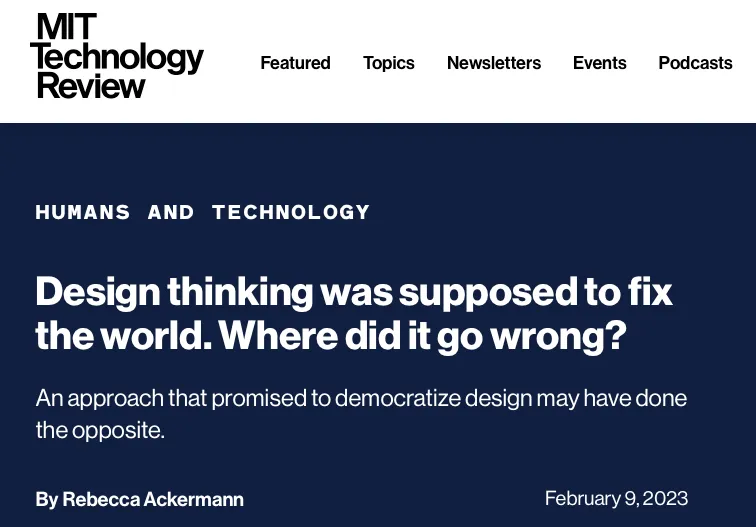Can I tell you how tired I am of reading that this thing or that thing is “dead”? Here’s just a tiny taste of articles from the last year:
Why Digital Transformation Is Dead And It’s Too Late To Cross The Chasm
Design Sprints are dead, long live the AI Sprints?
And this oldie from 2011(!!).
Design Thinking Is A Failed Experiment. So What’s Next?
Every time I see one of these articles, I find them superficial, boring, and lazy. At best.
At worst, someone is declaring something dead to sell you something else. Who wants to buy something that’s dead when you can buy this new shiny object?
Let me tell you what I really think:
I stumbled across this article last week from MIT’s Tech Review:
Design thinking was supposed to fix the world. Where did it go wrong?

I understand that media outlets are in the business of selling advertising and that journalists tend to prefer writing about conflict since it tends to sell (see above). And that the editors, even engineers, are not above the click-bait.
Sadly, this article could have been (should have been) about how a young design thinking discipline (less than 15 years old by Rebecca’s count) is evolving, neededly, in really a pretty short time. All of the ingredients are in the article, but that’s not very sexy journalism.
But the essence of this design discipline: Empathy, testing, iteration — holds true now more than ever. The article is a testament to how human-centered design is applying its own techniques and processes on itself — it’s learning, evolving empathizing and iterating.
I think the only people today who would argue against the Empathy/Testing/Iterate approach are those who have swallowed the Palo Alto Capitalism spin.
Adding systems design into human centered design to account for complexity isn’t new but it’s necessary. Adding ethics into any design system is critical, not only in design thinking. BTW, most of the resistance isn’t from designers — it’s from the decision makers (many with degrees from MIT and Stanford).
Every article declaring something is dead tends to show people reacting this way:
“I believed the hype — I bought it hook, line, and sinker and it turns out NOT to be the unicorns and rainbows mommy promised me!!! So now I’m going to throw a little tantrum.”

Suggestion: don’t believe the hype. A lot of what we want to call “dead” need the time and space to evolve, or to fall by the wayside. When they fall, we usually don’t notice it — there is no flashy funeral or wake.
I think the most exciting part about design and innovation is its evolution and rediscovery — it isn’t a perfect science but through trial and error we make it better and better over time.
I say: Enough with the digital and innovation and design coroners!!
Take Voltaire’s advice and cultivate your own garden rather than tending to your cemetery.








